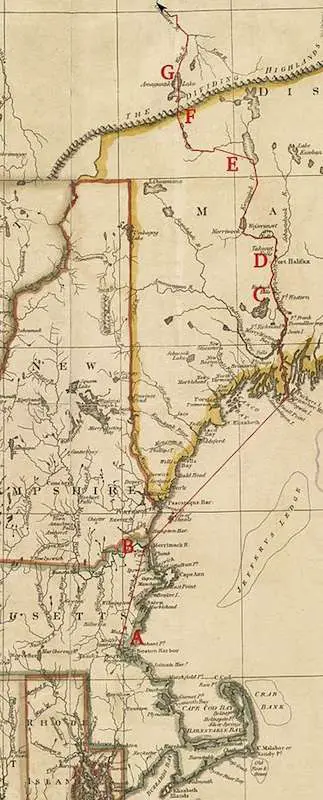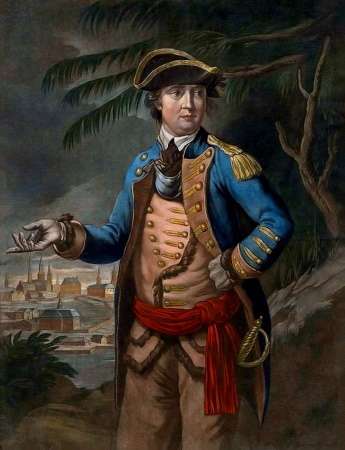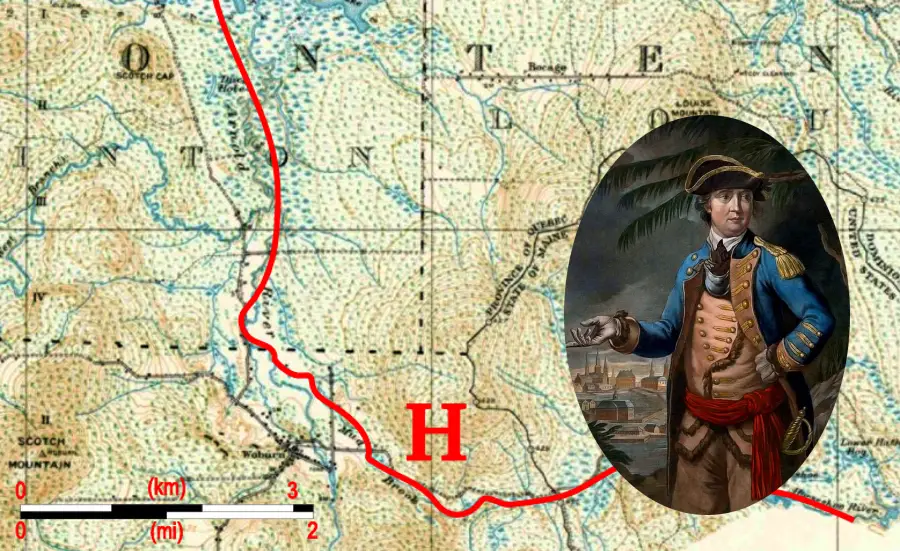Revolutionary War soldier Caleb Haskell must have thought Arnold’s expedition to Quebec was a good idea. He signed up for it during the Siege of Boston. Benedict Arnold had persuaded George Washington that the British would use Quebec to launch military operations. Arnold had traded in the region and believed Quebec was lightly defended.

Detail of 1795 map overlaid with Arnold’s expedition route. A Cambridge; B Newburyport; C Fort Western; D Fort Halifax; E Great Carrying Place; F Height of Land; G Lake Megantic. Courtesy Boston Public Library.
In the fall of 1775, Benedict Arnold led a force of 1,100 Continental troops from Cambridge, Mass., to Quebec City. Richard Montgomery led another expedition to invade Quebec from Lake Champlain.
It didn’t go well. Arnold’s men traveled 350 miles – twice as far as they planned — through poorly charted wilderness in what is now Maine. The men endured grueling portages up the Kennebec River. The boats leaked, ruining precious gunpowder and food supplies. By the time Arnold reached the French settlements above the St. Lawrence River, he had only 600 starving men. The siege of Quebec failed.
Caleb Haskell Signs Up
On May 5, 1775, Caleb Haskell enlisted as a soldier in the American Army in Newburyport, Mass. From that day through May 30, 1776, he kept a diary.
He described marching to Cambridge, where his unit under Capt. Ezra Lunt participated in the Siege of Boston. There was guard duty, Sunday worship, parading on the common, skirmishing with the enemy, seizing cattle and cannon. He made it through the Battle of Bunker Hill unscathed.

Col. Benedict Arnold, before his promotion to general
Caleb Haskell signed up for Arnold’s expedition to Quebec on Sept. 11. He marched to Newburyport and, a week later, boarded one of the 11 transport ships bound for Canada.
On Tuesday, Sept. 19, he recorded in his diary the troops’ departure:
This day about 9 o’clock weighed our anchors, and came to sail with a southwardly wind. After we got over the bar, we lay to, waiting for orders from the Commodore. At 10 o’clock received orders.
First signal.–Signal for speaking with the whole fleet: Ensign at main-topmast head.
Second signal.–Signal for chasing a sail: Ensign at fore-topmast head.
Third signal.–Signal for heaving to in the night: Lantern at mast-head, and two lights if head on shore, and three guns if head off shore.
Fourth signal.–For making sail in the night. Lantern at mast-head and four guns; and jack at fore-topmast head in the day.
Fifth signal.–For dispersing, and every vessel making the nearest harbor: Ensign at main-peak.
Sixth signal.–For boarding any vessel: Jack at main-topmas head and the fleet to draw up in line as near as possible.
N.B. No small arms to be fired at three o’clock.
The jack was hoisted on board the Commodore. We made sail with a fine breeze; in the evening, the wind blew quick at S.E. About 1 o’clock we hove to and lay until morning.
Arnold’s route through northern Maine is listed on the National Register of Historic Places as the Arnold Trail to Quebec.
This story updated in 2022.

16 comments
My 6th Great Grandfather Captain James Howard commanded Fort Western and was also a friend of Arnold’s (until he turned on the Colonialists). After the war, the Fort was decommissioned and Captain Howard (now also the Judge of this Maine Province of the Commonwealth of Massachusetts) purchased the property and over an additional 500 acres. Then two of his sons (William & Samuel) converted the Fort into a large family home and store (post office/bank/swap shop). This new settlement eventually became Maine’s capital Augusta. Old Fort Western still exists today, and is the oldest wooden fort in the US, as a wonderful museum – where time has stood still. It’s a MUST SEE, for history buffs! http://www.oldfortwestern.org/
Sitting in Newburyport right now on the river.
Oh, what is Kenneth Roberts wonderful book about this catastrophe?
[…] Caleb Haskell had enlisted as a soldier in the American Army in Newburyport, Mass. in May 1775. He marched to Cambridge, participated in the Siege of Boston and survived the Battle of Bunker Hill unscathed. Then he marched back to Newburyport with Arnold, boarded one of 11 transport ships and set sail for what is now Maine on Sept. 19, 1775. […]
[…] Pvt. Haskell kept a diary from the time he enlisted in the American Army in May 1775. After the Battle of Bunker Hill and the early days of the Siege of Boston, he volunteered for the invasion of Canada and marched back to Newburyport with Arnold. In September he boarded one of 11 transport ships and set sail for what is now Maine. […]
[…] Caleb Haskell enlisted in the Continental Army Newburyport on May 5, 1775. He participated in the Siege of Boston until September, when he signed up for Arnold’s expedition. Arnold badly miscalculated the hardship his men would suffer on the march, which was twice as long as he planned. The men endured grueling portages up the Kennebec River. The boats leaked, ruining precious gunpowder and food supplies. […]
[…] bottled up in Boston, but that looked likely to change soon. Washington was getting reports that Arnold’s expedition to Quebec had failed miserably. He had sent 1,100 men through rough terrain and bitter weather to block the […]
[…] Arnold Expedition was a disaster. Arnold’s men traveled 350 miles – twice as far as they planned — through […]
Caleb was my great grandfather’s great grandfather.
[…] from Canada. Rebels began building the fort in July 1776, a week after the return of the disastrous Arnold Expedition to Canada. It was known as East Point or Rattlesnake Hill until July 28, 1776, when Col. Arthur St. Clair […]
[…] since it was founded. The new country lacked accurate maps, a vexing problem for mariners and military planners. Astronomical observations established latitude and longitude – and hence good maps – in the […]
[…] trails in New England. During the American Revolution, they were used for military maneuvers. Benedict Arnold followed both, the Kennebec Trail to his regret and the Mohawk Trail to his satisfaction – he captured Fort Ticonderoga at the end […]
[…] got its name from the flagstaff Benedict Arnold planted on the Arnold Expedition to Quebec. A dam on the Dead River submerged the town in […]
[…] about the Penobscot Expedition, you might like to read about Benedict Arnold's expedition to Quebec here. This story was updated in […]
[…] In September 1775, the Continental Congress sent two expeditions to invade Quebec. One initially consisted of 2,000 men commanded by Brig. Gen. Richard Montgomery. They sailed up Lake Champlain toward Montreal, where they captured Fort St. John. Then they marched to Quebec, where they joined the second expedition led by Col. Benedict Arnold. […]
[…] George Washington wanted to win the support of French-Canadian Catholics as his army prepared to invade Canada. He also wanted to keep the colonies — including Catholic Maryland — united. […]
Comments are closed.